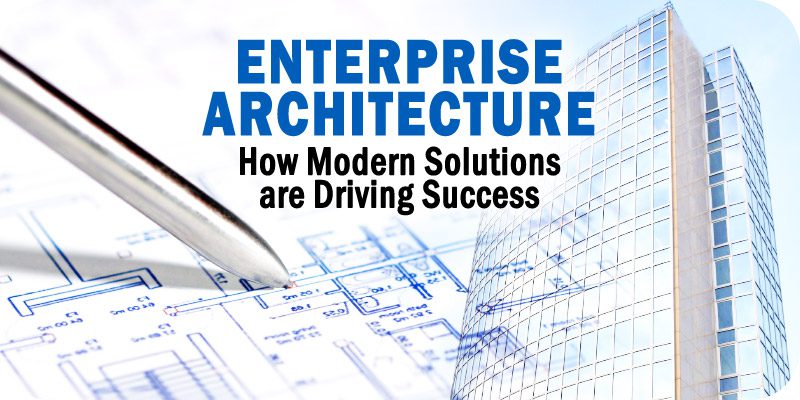How Modern Enterprise Architecture Drives Enterprise Success
 The need for cross-functional, distributed technology ownership is the perfect
ecosystem for the enterprise architect to shine. Traditionally, EA has governed
and exerted control over technology. However, as this becomes decentralized
across the business and, thus, influenced by EAs, innovations become
collaborative rather than authoritarian. Leaders can leverage the Enterprise
Architect in their change initiatives. By pooling data across departments,
executives can support their assertions on which areas of the business would
benefit most from a change in design. Modeling projects means they can be
compared simultaneously, helping to uncover which strategy will yield the
greatest returns. EA-driven roadmaps can help leaders consider KPIs a year or
ten years into the future of the business, made more solid by knowledge
distilled directly from those closest to the respective tools and processes they
use. Technology acquisition and skill dependencies cross product boundaries,
regulatory compliance processes intersect many different processes,
enterprise-wide cost objectives span multiple siloes, and cybersecurity threats
could rear up anywhere.
The need for cross-functional, distributed technology ownership is the perfect
ecosystem for the enterprise architect to shine. Traditionally, EA has governed
and exerted control over technology. However, as this becomes decentralized
across the business and, thus, influenced by EAs, innovations become
collaborative rather than authoritarian. Leaders can leverage the Enterprise
Architect in their change initiatives. By pooling data across departments,
executives can support their assertions on which areas of the business would
benefit most from a change in design. Modeling projects means they can be
compared simultaneously, helping to uncover which strategy will yield the
greatest returns. EA-driven roadmaps can help leaders consider KPIs a year or
ten years into the future of the business, made more solid by knowledge
distilled directly from those closest to the respective tools and processes they
use. Technology acquisition and skill dependencies cross product boundaries,
regulatory compliance processes intersect many different processes,
enterprise-wide cost objectives span multiple siloes, and cybersecurity threats
could rear up anywhere.What Is Augmented Data Management?
Augmented master data management applies ML and AI techniques to the management of master data. This enables companies to refine master data to achieve two key objectives: to optimize their business operations to run more efficiently and transform their businesses to drive growth. In terms of business optimization, this can be achieved in several ways using augmented master data management. First, there’s enhanced efficiency. With augmented master data management, companies can streamline business processes, which reduces the time needed to work on activities, thereby increasing efficiency and potentially leading to cost savings. Augmented master data management can also improve the ability to comply with regulations. The number of regulations and demands on companies has been increasing; for example, we’ve seen this lately with ESG reporting and privacy laws. From a data perspective, it can be tedious and complex for companies to comply with these regulations.Data is a stumbling block for most multicloud deployments
 Migrating data from one cloud service to another can be challenging. It is
important to have a solid data portability strategy in place that considers
data format, size, and dependencies. Most of those moving to multicloud can’t
answer this question: “What would it take to migrate this data set from here
to there?” This needs to be in your back pocket, as we’re seeing some data
sets move from single and multicloud deployments back to on premises. You must
give yourselves options. ... Managing data across multiple cloud services can
be a resource-intensive task if you attempt to do everything manually. It is
essential to have a centralized data management system in place that can
handle diverse data sources and ensure data consistency. Again, this needs to
be centralized, abstracted above the public cloud providers and native data
management implementations. You need to deal with data complexity on your
terms, not the terms of the data complexity itself. Most are opting for the
latter, which is a huge mistake.
Migrating data from one cloud service to another can be challenging. It is
important to have a solid data portability strategy in place that considers
data format, size, and dependencies. Most of those moving to multicloud can’t
answer this question: “What would it take to migrate this data set from here
to there?” This needs to be in your back pocket, as we’re seeing some data
sets move from single and multicloud deployments back to on premises. You must
give yourselves options. ... Managing data across multiple cloud services can
be a resource-intensive task if you attempt to do everything manually. It is
essential to have a centralized data management system in place that can
handle diverse data sources and ensure data consistency. Again, this needs to
be centralized, abstracted above the public cloud providers and native data
management implementations. You need to deal with data complexity on your
terms, not the terms of the data complexity itself. Most are opting for the
latter, which is a huge mistake. Understanding the Role of CIOs in Test Data Management
A zero-trust framework is a cyber security approach wherein all users and systems are not trusted and under authentication before granting access. Only users who are verified by the protocol get access to the designs. It is a great leap over traditional cybersecurity models that primarily operate on assumptions. To fully achieve the zero trust frameworks, automation of test data through a DevOps Platform is performed. Given the responsibility of implementing cyber security throughout the enterprise, a CIO is influential here. The leader has to roll out the DevSecOps approach that integrates cyber security from the beginning. The real challenge here is to build a culture of not treating security as an afterthought. It should be a part of the SDLC and a CIO should educate all stakeholders about the same. With DevSecOps, they work towards pipelining the DevOps pieces with security protocols. A CIO has to upgrade an enterprise’s approach towards risk and security in test data and perfect the delivery pipeline of qualitative data sets for different environments.A step-by-step guide to setting up a data governance program
 Data governance is a crucial aspect of managing an organization’s data assets.
The primary goal of any data governance program is to deliver against
prioritized business objectives and unlock the value of your data across your
organization. Realize that a data governance program cannot exist on its own –
it must solve business problems and deliver outcomes. Start by identifying
business objectives, desired outcomes, key stakeholders, and the data needed
to deliver these objectives. Technology and data architecture play a crucial
role in enabling data governance and achieving these objectives. Don’t try to
do everything at once! Focus and prioritize what you’re delivering to the
business, determine what you need, deliver and measure results, refine,
expand, and deliver against the next priority objectives. A well-executed data
governance program ensures that data is accurate, complete, consistent, and
accessible to those who need it, while protecting data from unauthorized
access or misuse.
Data governance is a crucial aspect of managing an organization’s data assets.
The primary goal of any data governance program is to deliver against
prioritized business objectives and unlock the value of your data across your
organization. Realize that a data governance program cannot exist on its own –
it must solve business problems and deliver outcomes. Start by identifying
business objectives, desired outcomes, key stakeholders, and the data needed
to deliver these objectives. Technology and data architecture play a crucial
role in enabling data governance and achieving these objectives. Don’t try to
do everything at once! Focus and prioritize what you’re delivering to the
business, determine what you need, deliver and measure results, refine,
expand, and deliver against the next priority objectives. A well-executed data
governance program ensures that data is accurate, complete, consistent, and
accessible to those who need it, while protecting data from unauthorized
access or misuse.Why Businesses Need To Think Bigger When It Comes To Automation
 Far too often, automation projects are approached as siloed, one-off
opportunities to fine-tune a specific business process or function. Maybe it's
the introduction of a conversational AI tool to improve front-line customer
support functions or the development of a new payment processing or credit
decisioning solution to build out a digital payments infrastructure. Whatever
the specific use case, automation projects that approach a singular vision to
make one part of the business faster or more efficient regularly fail because
they simply aren't big enough. To really extract value from automation, these
projects need to start with an enterprise-wide vision and break down the walls
between data, analytics, digital and operational teams to redefine business
processes across multiple functions. Put simply, businesses need to stop
thinking about automation and start focusing on hyperautomation. Businesses
that understand this distinction and embrace automation not as a focused
cost-cutting project but as an opportunity to transform legacy business and IT
processes into a fully synchronized, smart workflow should be well positioned
to confront the challenges of the current marketplace.
Far too often, automation projects are approached as siloed, one-off
opportunities to fine-tune a specific business process or function. Maybe it's
the introduction of a conversational AI tool to improve front-line customer
support functions or the development of a new payment processing or credit
decisioning solution to build out a digital payments infrastructure. Whatever
the specific use case, automation projects that approach a singular vision to
make one part of the business faster or more efficient regularly fail because
they simply aren't big enough. To really extract value from automation, these
projects need to start with an enterprise-wide vision and break down the walls
between data, analytics, digital and operational teams to redefine business
processes across multiple functions. Put simply, businesses need to stop
thinking about automation and start focusing on hyperautomation. Businesses
that understand this distinction and embrace automation not as a focused
cost-cutting project but as an opportunity to transform legacy business and IT
processes into a fully synchronized, smart workflow should be well positioned
to confront the challenges of the current marketplace.Surge of swatting attacks targets corporate executives and board members
 The way it works in this new corporate swatting surge is that the malicious
actors go to the websites of corporations, identify the top executives and
board members, and with lists in hand, visit the websites of data brokers such
as 411.com, Spokeo, and others. While there, the swatters grab whatever they
can – names, addresses, phone numbers, email addresses, whatever is available.
It is a "one-stop shop for finding the locations of executives and corporate
officers," says Pierson. Alternatively, the threat actors plumb the archives
of content aggregated from thousands of data breaches over the years. The
swatter can easily find out that an executive "ordered new jogging shorts or
whatever" and where those shorts were shipped, he says. Once the
cybercriminals have that information, they do one of two things: use
synthesized voice devices or make robotic recordings and call the police. The
messages generally focus on a hostage or murder situation.
The way it works in this new corporate swatting surge is that the malicious
actors go to the websites of corporations, identify the top executives and
board members, and with lists in hand, visit the websites of data brokers such
as 411.com, Spokeo, and others. While there, the swatters grab whatever they
can – names, addresses, phone numbers, email addresses, whatever is available.
It is a "one-stop shop for finding the locations of executives and corporate
officers," says Pierson. Alternatively, the threat actors plumb the archives
of content aggregated from thousands of data breaches over the years. The
swatter can easily find out that an executive "ordered new jogging shorts or
whatever" and where those shorts were shipped, he says. Once the
cybercriminals have that information, they do one of two things: use
synthesized voice devices or make robotic recordings and call the police. The
messages generally focus on a hostage or murder situation. Governance, Processes and Planning: Three Significant Countermeasures to Being Hacked
Together, governance, processes and planning help organizations to effectively manage and protect their digital assets by providing a clear framework for decision-making, establishing clear procedures for incident response and risk management, and developing a comprehensive security strategy that aligns with the organization’s overall goals and priorities. Through governance, processes and planning, your organization can start to fix the people vulnerability. So how can your organization develop and implement governance, processes and planning countermeasures? ISACA’s CMMI Cybermaturity Platform is a great place to start. The CMMI Cybermaturity Platform will help your organization identify what it does well and where your weaknesses are. The CMMI Cybermaturity Platform also aids your organization in showing where your gaps are in governance, processes and planning, three often overlooked critical countermeasures to hacking. The CMMI Cybermaturity Platform is an easy-to-use architecture model that simplifies identifying gaps in new or existing cybersecurity programs.What is predictive analytics? Transforming data into future insights
 Predictive analytics makes looking into the future more accurate and reliable
than previous tools. As such it can help adopters find ways to save and earn
money. Retailers often use predictive models to forecast inventory
requirements, manage shipping schedules, and configure store layouts to
maximize sales. Airlines frequently use predictive analytics to set ticket
prices reflecting past travel trends. Hotels, restaurants, and other
hospitality industry players can use the technology to forecast the number of
guests on any given night in order to maximize occupancy and revenue. By
optimizing marketing campaigns with predictive analytics, organizations can
also generate new customer responses or purchases, as well as promote
cross-sell opportunities. Predictive models can help businesses attract,
retain, and nurture their most valued customers. Predictive analytics can also
be used to detect and halt various types of criminal behavior before any
serious damage is inflected.
Predictive analytics makes looking into the future more accurate and reliable
than previous tools. As such it can help adopters find ways to save and earn
money. Retailers often use predictive models to forecast inventory
requirements, manage shipping schedules, and configure store layouts to
maximize sales. Airlines frequently use predictive analytics to set ticket
prices reflecting past travel trends. Hotels, restaurants, and other
hospitality industry players can use the technology to forecast the number of
guests on any given night in order to maximize occupancy and revenue. By
optimizing marketing campaigns with predictive analytics, organizations can
also generate new customer responses or purchases, as well as promote
cross-sell opportunities. Predictive models can help businesses attract,
retain, and nurture their most valued customers. Predictive analytics can also
be used to detect and halt various types of criminal behavior before any
serious damage is inflected. 5 top workforce concerns for CIOs
 Mental health has become a critical concern in the workplace, particularly as
the global workforce resets following the COVID-19 pandemic. The prolonged
stress and uncertainty of the past several years, coupled with a shaky
economy, has taken a toll on many employees, and they are looking for support
and resources to help them cope. A key part of supporting employee mental
health is eliminating the stigma around taking time to recharge mentally. ...
High employee engagement is an ongoing objective for organizations, as engaged
employees are more likely to be productive, motivated, and committed to their
work. However, employee engagement has steadily declined throughout the Great
Resignation, “quiet quitting,” and recent tech layoffs. To boost engagement,
focus on creating a positive and supportive work environment, fostering open
communication, and providing opportunities for employee growth and
development. Also, seek feedback from employees to understand their needs and
concerns and work to address them.
Mental health has become a critical concern in the workplace, particularly as
the global workforce resets following the COVID-19 pandemic. The prolonged
stress and uncertainty of the past several years, coupled with a shaky
economy, has taken a toll on many employees, and they are looking for support
and resources to help them cope. A key part of supporting employee mental
health is eliminating the stigma around taking time to recharge mentally. ...
High employee engagement is an ongoing objective for organizations, as engaged
employees are more likely to be productive, motivated, and committed to their
work. However, employee engagement has steadily declined throughout the Great
Resignation, “quiet quitting,” and recent tech layoffs. To boost engagement,
focus on creating a positive and supportive work environment, fostering open
communication, and providing opportunities for employee growth and
development. Also, seek feedback from employees to understand their needs and
concerns and work to address them.Quote for the day:
"Great leaders go forward without stopping, remain firm without tiring and remain enthusiastic while growing" -- Reed Markham
No comments:
Post a Comment